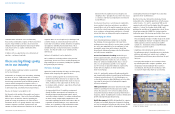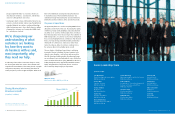Bank of Montreal 2013 Annual Report Download - page 14
Download and view the complete annual report
Please find page 14 of the 2013 Bank of Montreal annual report below. You can navigate through the pages in the report by either clicking on the pages listed below, or by using the keyword search tool below to find specific information within the annual report.
Financial Performance and Condition at a Glance
Our Performance (Note 1) Peer Group Performance Our Performance (Note 1) Peer Group Performance
Total Shareholder Return (TSR) P 33 17.4 TSR (%) Credit Losses P 42, 77, 84 Provision for Credit Losses as a % of Average
Net Loans and Acceptances
• BMO shareholders have earned an average annual return 10.8 11.5 • The Canadian peer group average annual three-year TSR • The adjusted provision for credit losses (PCL) was $359 million,
of 11.5% over the past three years, above the 4.8% return was 12.0%. The one-year TSR was 22.4% and the five-year down from $471 million in 2012. Reported PCL was $589 million, •
The Canadian peer group average PCL represented
on the S&P/TSX Composite Index. average annual TSR was 15.6%. down from $765 million. The decline in adjusted PCL reflects 0.56 0.54
33 basis points of average net loans and acceptances,
• The one-year TSR of 28.8% and the five-year average • The North American peer group average annual three-year decreases in provisions in all of our operating groups, offset in part
down from 37 basis points in 2012.
annual TSR of 17.0% both outperformed the comparable TSR was 12.7%, slightly above the Canadian peer group by lower recoveries on the purchased credit impaired loan portfolio. •
The North American peer group average PCL represented
Canadian indices. average. The one-year TSR in 2013 was 21.3% and the • Adjusted PCL as a percentage of average net loans and acceptances
36 basis points, down from 53 basis points in 2012,
0.31
2011 2012 2013 five-year average annual TSR was 6.1%. improved to 14 basis points from 21 basis points a year ago,
Graph shows average annual three-year TSR. and reported PCL as a percentage of average net loans and
acceptances improved to 22 basis points from 31 basis points.
These positive ratio trends reflect lower provisions across both our
Earnings per Share (EPS) Growth EPS Growth (%)
P 35 consumer and commercial loan portfolios and all of our operating
27
• Adjusted net income grew $184 million or 5% to • The Canadian peer group average EPS increased 3%, groups, compared to 2012. 2011
$4,276 million in 2013, and adjusted EPS grew $0.30 with all but two banks in the peer group reporting
or 5% to $6.30. Reported net income grew $59 million increases in EPS.
to $4,248 million, and reported EPS grew $0.11 or P 84
18 • Average EPS growth for the North American peer group was Impaired Loans
2% to $6.26. 69%, with significant variability among our U.S. peer banks. • Gross impaired loans and acceptances (GIL), excluding
• There was revenue growth and lower provisions purchased credit impaired loans, decreased to $2,544 million 8.98
for credit losses on an adjusted basis. 6 25 from $2,976 million in 2012, and represented 7.61% of equity
2 and allowances for credit losses, compared with 9.30% a year ago.
• Formations of new impaired loans and acceptances, a key driver
All EPS measures are stated on a diluted basis. 2011 2012 2013 North American peer group data is not to scale. of provisions for credit losses, were $2,449 million, down from
$3,101 million in 2012, primarily due to a $535 million decrease
in formations in the purchased performing loan portfolio.
53
Net Economic Profit (NEP) Growth P 36 NEP Growth (%)
• Adjusted NEP, a measure of added economic value, 2011
was $1,237 million, down $9 million or 1% from 2012. 28
Reported NEP was $1,298 million, down $141 million 19
15
or 10% from 2012. Capital Adequacy P 61
•
The decrease is reflective of higher earnings being more
• BMO’s Basel III Common Equity Tier 1 (CET1) Ratio exceeds 8.7
than offset by
a higher charge for capital, as a result of
(1) regulatory requirements.
growth in
shareholders’ equity. (10) • The Basel III CET1 Ratio was 9.9%, up from 8.7% on
2011 2012 2013 NEP data is not available for all banks in the peer group. a pro-forma basis in 2012, primarily due to an increase
in common equity.
Return on Equity (ROE) P 36 ROE (%)
• Adjusted ROE was 15.0% and reported ROE was 14.9% •
The Canadian peer group average ROE of 18.3% was
15.116.0 15.9 15.5 14.9 15.0
in 2013, compared with 15.5% and 15.9%, respectively,
lower than the average return of 20.1% in 2012, as ROE
in 2012. There was growth in both reported and adjusted
declined for all but one bank in our Canadian peer group.
*2012 Basel III CET1 Ratio is a pro-forma estimate. 2012*
earnings available to common shareholders. There was •
Average ROE for the North American peer group was
also an increase in average common shareholders’ equity
12.2%, unchanged from 2012.
Credit Rating P 94
primarily due to internally-generated capital. • Credit ratings for BMO’s long-term debt, as assessed by the four major
past 24 years, one of only two banks in our North American
• BMO has achieved an ROE of 13% or better in 23 of the rating agencies, are listed below and all four ratings are considered to
peer group to have done so. 2011 2012 2013 indicate high-grade, high-quality issues. On January 28, 2013, Moody’s
lowered the long-term senior debt ratings of six Canadian banks, including
BMO, by one notch and removed systemic support from the ratings of
16
Revenue Growth P 38 Revenue Growth (%) all rated Canadian banks’ subordinated debt instruments. Moody’s affirmed
14 • Revenue growth for the Canadian peer group averaged BMO’s short-term rating.
• Adjusted revenue increased $505 million or 3% in 12
10 4%, less than half the average growth of 9% in 2012.
2013 to $15,572 million. Reported revenue increased • Average revenue growth for the North American peer
$133 million to $16,263 million. The increase was 1 group was 2%, a decline from 4% in 2012, with three
primarily due to revenue growth in Wealth Management, 3 of our U.S. peers reporting lower revenues.
BMO Capital Markets and Canadian P&C.
2011 2012 2013
63.5 63.1 63.3 63.1
62.7 61.5
Efficiency Ratio Effi ciency Ratio (%)
P 43
(Expense-to-Revenue Ratio) • The Canadian peer group average efficiency ratio was
59.1%, up from 58.3% in 2012 as increases in expenses
from 2012. The reported efficiency ratio improved
• The adjusted efficiency ratio was 63.1%, unchanged
more than offset revenue growth.
20 basis points to 63.3%, as revenue growth was higher • The average efficiency ratio for the North American peer
than expense growth. group was 62.7%, slightly better than the group’s average
ratio of 63.0% in 2012, and worse than the average of *Data for all years reflects the peer group composition in the most recent year.
2011 2012 2013 our Canadian peer group.
and was slightly higher than the average PCL for the
0.22
0.21
Canadian peer group.
0.14
2012 2013
Gross Impaired Loans and Acceptances as a %
of Equity and Allowances for Credit Losses
9.30 • The Canadian peer group average ratio of GIL as a
7.61 percentage of equity and allowances for credit losses
was 5.66% in 2013, down from 6.40% in 2012.
• The average ratio for our North American peer group
improved from 11.32% a year ago to 9.55% in 2013,
but continues to be higher than the average for the
Canadian peer group.
2012 2013
Capital Adequacy
9.9 • The Canadian peer group average Basel III CET1 Ratio
was 9.2% in 2013, compared to an average pro-forma
CET1 Ratio of 8.3% a year ago.
• The basis for computing capital adequacy ratios
in Canada and the United States is not comparable.
2013
Credit Rating
• Moody’s Canadian peer group median credit rating was lower in 2013 compared
with 2012, as Moody’s downgraded the senior long-term debt ratings for four
of our Canadian peers by one notch.
• S&P’s Canadian peer group median credit rating was also lower in 2013, as
S&P downgraded the long-term debt ratings of one of our Canadian peers
by one notch.
• The credit ratings awarded by the two remaining ratings agencies to the
Canadian peer group were unchanged.
• Moody’s North American peer group median credit rating was lower compared
with 2012, as Moody’s downgraded the ratings for two of our U.S. peers by one
notch and upgraded the rating of one of our U.S. peers by two notches. The
North American peer group median credit ratings remain slightly lower than
the median of the Canadian peer group for two of the ratings.
BMO Financial Group Canadian peer group median* North American peer group median*
2011 2012 2013 2011 2012 2013 2011 2012 2013
DBRS AA AA AA DBRS AA AA AA DBRS AAL AAL AAL
Fitch AA– AA– AA– Fitch AA– AA– AA– Fitch AA– AA– AA–
Moody’s Aa2 Aa2 Aa3 Moody’s Aa1 Aa2 Aa3 Moody’s Aa3 Aa3 A1
S&P A+ A+ A+ S&P AA– AA– A+ S&P A+ A+ A+
Note 1: NEP and adjusted results in this section are non-GAAP. Please see the Non-GAAP Measures section on page 34.
Since November 1, 2011, BMO’s financial results and those of our Canadian peers have been reported in accordance with IFRS. The consolidated fi nancial
statements for comparative periods in fiscal year 2011 have been restated. 2011 growth rates are based on Canadian GAAP in 2010 and IFRS in 2011, and
may not be meaningful. U.S. peer group data continues to be reported in accordance with U.S. GAAP.
In 2013, we changed the methodology for the Canadian and North American peer group averages to a simple-average calculation from a weighted-average
calculation, and restated prior periods.
BMO reported
BMO adjusted
Canadian peer group average
North American peer group average
The Canadian peer group averages exclude BMO and are based on the performance of Canada’s five other largest banks: Canadian Imperial Bank of
Commerce, National Bank of Canada, RBC Financial Group, Scotiabank and TD Bank Financial Group. The North American peer group averages are based on the
performance of 12 of the largest banks in North America. These include the Canadian peer group, except National Bank of Canada, as well as BB&T Corporation,
Bank of New York Mellon, Fifth Third Bancorp, Key Corp., The PNC Financial Services Group Inc., Regions Financial, SunTrust Banks Inc. and U.S. Bancorp.
Results are as at or for the years ended October 31 for Canadian banks and as at or for the years ended September 30 for U.S. banks.
BMO reported
BMO adjusted
Canadian peer group average
North American peer group average
24 BMO Financial Group 196th Annual Report 2013 BMO Financial Group 196th Annual Report 2013 25
























